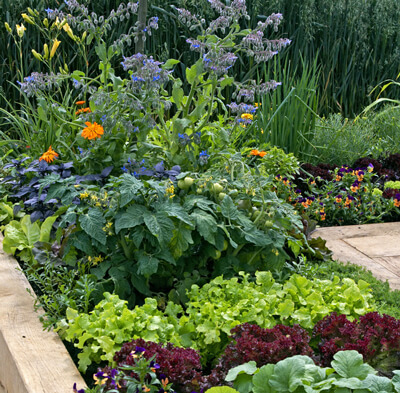Companion Planting
 Companion Planting for a Healthy Garden
Companion Planting for a Healthy Garden
Companion planting is a natural and highly efficient way to get the most out of your gardening efforts. Companion planting not only enhances growth, beauty, and flavor, but it also makes the most of limited space and time. This makes gardening more simple and productive for those with busy schedules. By determining your specific gardening goals, you can choose which plant combinations are right for you. Whether you wish to attract beneficial insects to your garden, maximize weed control, find plants that repel flies, use a natural pesticide or conserve space, here are a few great gardening tips on how to utilize companion planting in your garden.
Insect Control
It might seem counterproductive to invite pests into your garden, but by luring in beneficial insects you are actually practicing one of the oldest and best forms of organic pest control. Beneficial insects such as pollinators like bees, and butterflies as well as predictor insects like ladybugs and praying mantis help to pollinate your garden for a bigger harvest and help rid of harmful insects. You can even choose companion plants based on color and odor to keep the overpopulation of pesky pests out of your garden. These natural pesticides provide a chemical free way to maintain your garden. Companion planting offers many options for natural pesticides as well as plants that repel flies.
Weed Control

Space Conservation
Based on your specific companion needs our gardening tips can help make your small space generate a great output. Utilize the space you have for maximum growing potential by packing your garden with as many companion plants as you can. By not planting a massive amount of one plant species in an area you diversify your growing potential. Certain companion plants will add nutrients into the soil, provided coverage for low growing plants, help conserve water, maximize weed control and maintain a healthy environment where everything thrives in support of one another, serving a specific purpose.
![Companion Planting for protection and support]() Protection and Support
Protection and Support
By choosing your plants wisely you can provide them with the perfect protection and support needed to thrive. Companion planting has been practiced in various forms worldwide due to the environmental benefits of plants supporting each other in function. When planned properly companion plants can provide shade, deter harmful insects, add nutrients to the soil, invite pollinators, provide natural trellising, and maintain moisture. All of which are key factors in maintaining a healthy and happy growing environment.
You may have noticed the cyclical benefits to companion planting. Its nature’s time-tested and approved way of providing most everything necessary for maximum gardening productivity. With a little preplanning and our helpful gardening tips, you too can utilize nature’s natural defenses to create a thriving garden environment that is relatively easy to maintain.
A Few Companion Planting Tips:
-
Basil
Plant near: most garden crops
Keep away from: rue
Comments: improves the flavor and growth of garden crops, especially tomatoes and lettuce. Repels mosquitoes.
-
Broccoli and Brussels Sprouts
Plant near: beets, buckwheat, calendula, carrots, chamomile, dill, hyssop, marigolds, mints, nasturtiums, onions, rosemary, sage, thyme, wormwood.
Keep away from: strawberries
Comments: marigolds repel cabbage moths. Nasturtiums repel aphids. -
Cabbage and Cauliflower
Plant near: broccoli, brussels sprouts, celery, chard, spinach, tomatoes.
Keep away from: strawberries
Comments: tomatoes and celery repel cabbage worms.
-
Carrots
Plant near: cabbage, chives, early potatoes, leeks, lettuce, onions, peas, radishes, rosemary, sage, salsify, wormwood.
Comments: onions, leeks, and wormwood repel carrot flies -
Corn
Plant near: beans, cucumbers, early potatoes, melons, peas, pumpkins, soybeans, squash.
Comments: soybeans deter chinch bugs.
-
Cucumbers
Plant near: beans, cabbage, corn, early potatoes, radishes, sunflowers.
Keep away from: late potatoes
Comments: Radishes deter cucumber beetles. Cucumbers encourage blight in late potatoes. -
Dill
Plant near: broccoli, brussels sprouts, cabbage, cauliflower, cucumber, lettuce, onions
Keep away from: carrots
Comments: Improves flavor and growth of cabbage family plants. -
Garlic
Plant near: cabbage, cane fruits, fruit trees, roses, tomatoes
Keep away from: peas, beans
Comments: deters Japanese beetles and aphids. A garlic oil spray deters onion flies, aphids, and ermine moths. A garlic tea helps repel late potato blight.Source for information about the above specific companion plants: http://www.motherearthnews.com/organic-gardening/companion-planting-guide-zmaz81mjzraw
To view a more in-depth version of the above list of companion plants and for additional tips on companion planting, click here.
If you have questions about companion planting or additional measures you can take to protect your garden in a natural way, stop by your local SummerWinds Nursery to speak with one of our Trusted Garden Advisors!



